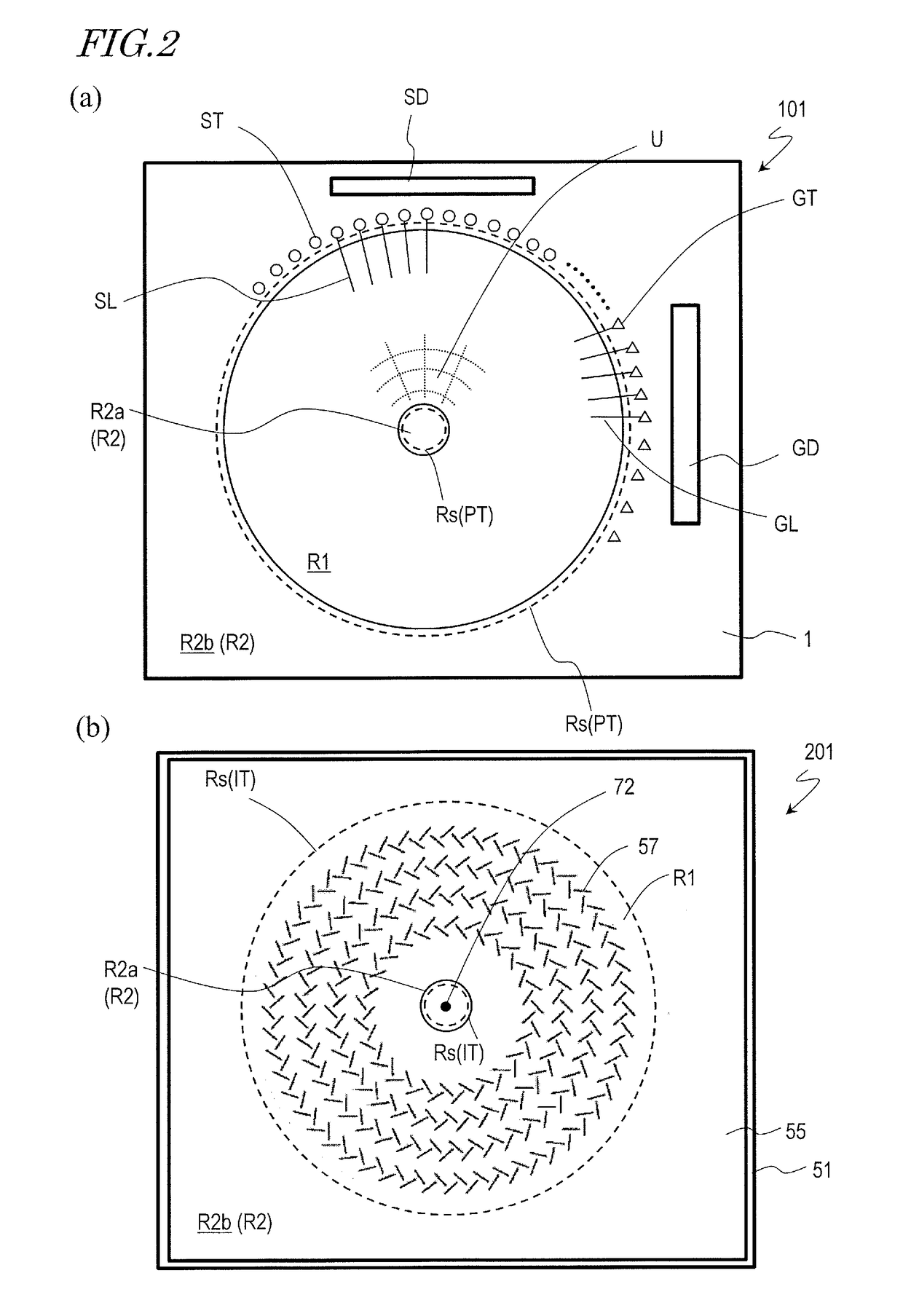TFT substrate, scanning antenna using same, and method for manufacturing TFT substrate
a scanning antenna and substrate technology, applied in the field of scanning antennas, can solve the problems of high cost of conventional phased array antennas, an obstacle to their widespread application to consumer products, and the increase of the number of antenna elements
- Summary
- Abstract
- Description
- Claims
- Application Information
AI Technical Summary
Benefits of technology
Problems solved by technology
Method used
Image
Examples
first embodiment
[0084]First, reference will be made to FIG. 1 and FIG. 2. FIG. 1 is a schematic partial cross-sectional view at around the center of the scanned antenna 1000 as described in detail above, and FIGS. 2(a) and 2(b) are schematic plan views showing the TFT substrate 101 and the slot substrate 201, respectively, of the scanned antenna 1000.
[0085]The scanned antenna 1000 includes a plurality of antenna elements U arranged in a two-dimensional arrangement, and the scanned antenna 1000 illustrated herein includes a plurality of antenna elements arranged in a concentric arrangement. In the following description, the region of the TFT substrate 101 or the slot substrate 201 corresponding to the antenna element U will be referred to as an “antenna element region” and will be denoted by the same reference sign U as the antenna element. As shown in FIGS. 2(a) and 2(b), in the TFT substrate 101 and the slot substrate 201, a region defined by a plurality of antenna element regions arranged in a tw...
second embodiment
[0180]A scanned antenna according to a second embodiment will be described with reference to the drawings. The TFT substrate of the scanned antenna of the present embodiment is different from the TFT substrate 101 shown in FIG. 2 in that the transparent conductive layer to be the upper connecting portions of the terminal portions is provided between the first insulating layer and the second insulating layer of the TFT substrate.
[0181]FIG. 8(a) to (c) are cross-sectional views showing the gate terminal portion GT, the source terminal portion ST and the transfer terminal portion PT, respectively, of the TFT substrate 102 of the present embodiment. Like elements to those of FIG. 4 are denoted by like reference signs and will not be discussed below. Note that the cross-sectional structure of the antenna element region U will not be shown in the figures or discussed below as it is similar to that of the embodiment described above (FIG. 3).
[0182]The gate terminal portion GT of the present...
third embodiment
[0198]A scanned antenna according to a third embodiment will be described with reference to the drawings. The TFT substrate of the scanned antenna of the present embodiment is different from the TFT substrate 102 shown in FIG. 8 in that the upper connecting portion formed of a transparent conductive film is absent in the transfer terminal portion.
[0199]FIG. 10(a) to (c) are cross-sectional views showing the gate terminal portion GT, the source terminal portion ST and the transfer terminal portion PT, respectively, of the TFT substrate 103 of the present embodiment. Like elements to those of FIG. 8 are denoted by like reference signs and will not be discussed below. Note that the structure of the antenna element region U will not be shown in the figures or discussed below as it is similar to that of the embodiment described above (FIG. 3).
[0200]The structure of the gate terminal portion GT and the source terminal portion ST is similar to the structure of the gate terminal portion and...
PUM
 Login to View More
Login to View More Abstract
Description
Claims
Application Information
 Login to View More
Login to View More - R&D
- Intellectual Property
- Life Sciences
- Materials
- Tech Scout
- Unparalleled Data Quality
- Higher Quality Content
- 60% Fewer Hallucinations
Browse by: Latest US Patents, China's latest patents, Technical Efficacy Thesaurus, Application Domain, Technology Topic, Popular Technical Reports.
© 2025 PatSnap. All rights reserved.Legal|Privacy policy|Modern Slavery Act Transparency Statement|Sitemap|About US| Contact US: help@patsnap.com



